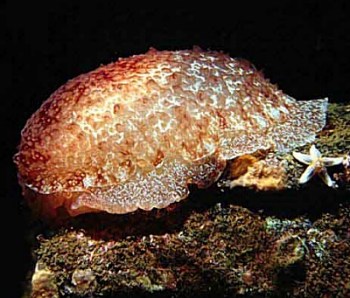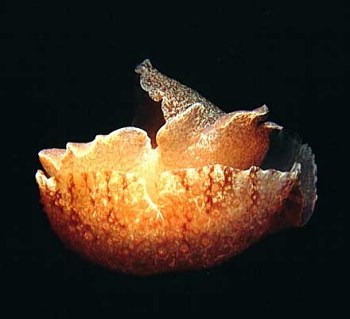Pleurobranchus membranaceus
April 21, 2001
From: Jim Anderson


Dear Dr Rudman,
I have attached the accompanying images of Pleurobranchus membranaceus to add to your list.
Based on my observations, these animals appear in our Scottish west coast sea lochs from April/May onwards when the sea temperature is around 9-10 deg C, leaving their distinctive large spiral ribbons of spawn on all sorts of substrates, mud, stones, gravel etc. We find them regularly from depths just below the LW line down to 20 m. They are approx 60 - 75 mm in dia and can be found until late autumn (that's November here). We have christened them as 'Highland Dancers' due to their swimming ability (upside down and sinuous mantle flapping) as the Spanish Dancers probably better known to you folks in the warmer seas. I have only once observed a specimen swimming without the prior intervention of a diver, it was 'headed' into shallower water at 12M in a loch that drops to 70M, so I am sure this is a natural behaviour and method of locomotion and not one induced by dive leaders to 'amuse' their charges.
These images and a general update of the Scottish Nudibranch website http://www.a4454.freeserve.co.uk/scotnud1.html will be online from 16 April.
Kind regards
Jim Anderson
jander4454@aol.com
Anderson, J., 2001 (Apr 21) Pleurobranchus membranaceus. [Message in] Sea Slug Forum. Australian Museum, Sydney. Available from http://www.seaslugforum.net/find/4189Thanks Jim,
I won't go too deeply into your image of a Highland Dancer 'upside down' with their kilt flapping. I remember being fascinated by Thompson & Slinn's account (1959) of swimming in Pleurobranchus membranaceus. They report a mass invasion of swimming animals at Port Erin, Isle of Man, and could find 3 or 4 earlier references to 'invasions of swimming animals' at Torbay and Plymouth in England.
A number of opisthobranchs swim by flapping wing-like structures (see Sagaminopteron ornatum and Aplysia extraordinaria) but P. membranaceus differs in the asynchronous nature of the flapping. It swims upside down. The mantle hangs down and is not used in swimming, while the sides of the foot extend out as large thin flaps, much larger than when the animal is crawling. During swimming the foot on one side flaps by sending a wave from the front to rear and then while it is recovering for the next propulsive stroke, the other side of the foot undergoes its propulsive stroke. This makes swimming a very ungainly unstable movement, the animals rolling from side to side as it swims along. Animals do not appear to swim in any direction. In Jim's lower photo we can see that the side of the foot at the back of the photo is extended for swimming, while the side of the foot closest to us is not.
Reference:
• Thompson, T.E. & Slinn, D.J. (1959) On the biology of the opisthobranch Pleurobranchus membranaceus. Journal of the Marine Biological Association, United Kingdom, 38: 507-524.
Best wishes,
Bill Rudman.
Related messages
-
Pleurobranchus membranaceus from Little Loch Broom, Scotland
From: Karen Williams, February 7, 2007 -
Pleurobranchus membranaceus egg-laying frenzy
From: Jim Anderson, June 15, 2006 -
Re: Pleurobranchus membranaceus feeding
From: Robert Smith, July 12, 2004 -
Re: Pleurobranchus membranaceus feeding
From: Jim Anderson, December 6, 2003 -
Re: Pleurobranchus membranaceus feeding
From: Jim Anderson, November 21, 2003 -
Pleurobranchus membranaceus - feeding
From: Jim Anderson, November 19, 2003 -
Pleurobranchus membranaceus and eggs
From: Jim Anderson, May 23, 2002 -
Re: 'Highland Dancer'
From: Jim Anderson, April 22, 2001
